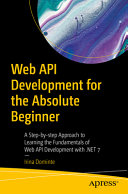Fundamentals of Web Development 3rd Edition by Randy Connolly , Ricardo Hoar ISBN 0135863333 978-0135863336
$50.00 Original price was: $50.00.$25.00Current price is: $25.00.
Fundamentals of Web Development 3rd Edition by Randy Connolly , Ricardo Hoar – Ebook PDF Instant Download/Delivery:0135863333, 978-0135863336
Full download Fundamentals of Web Development 3rd Edition after payment

Product details:
ISBN 10: 0135863333
ISBN 13: 978-0135863336
Author: Randy Connolly , Ricardo Hoar
Fundamentals of Web Development [RENTAL EDITION]
Table of contents:
- 1 Introduction to Web Development
- Chapter Objectives
- 1.1 A Complicated Ecosystem
- 1.2 Definitions and History
- 1.2.1 A Short History of the Internet
- 1.2.2 The Birth of the Web
- 1.2.3 Web Applications in Comparison to Desktop Applications
- 1.2.4 From Static to Dynamic (and Back to Static)
- 1.3 The Client-Server Model
- 1.3.1 The Client
- 1.3.2 The Server
- 1.3.3 Server Types
- 1.3.4 Real-World Server Installations
- 1.3.5 Cloud Servers
- 1.4 Where Is the Internet?
- 1.4.1 From the Computer to Outside the Home
- 1.4.2 From the Home to the Ocean’s Edge
- 1.4.3 How the Internet Is Organized Today
- 1.5 Working in Web Development
- 1.5.1 Roles and Skills
- Hardware Architect/Network Architect/Systems Engineer
- System Administrator
- Database Administrator/Data Architect
- Security Specialist/Consultant/Expert
- Developer/Programmer
- Front-End Developer/UX Developer
- Software Engineer
- UX Designer/UI Designer/Information Architect
- Tester/Quality Assurance
- SEO Specialist
- Content Strategists/Marketing Technologist
- Project Manager/Product Manager
- Business Analyst
- Nontechnical Roles
- 1.5.2 Types of Web Development Companies
- Hosting Companies
- Design Companies
- Website Solution Companies
- Vertically Integrated Companies
- Start-Up Companies
- Internal Web Development
- 1.6 Chapter Summary
- 1.6.1 Key Terms
- 1.6.2 Review Questions
- 1.6.3 References
- 2 How the Web Works
- Chapter Objectives
- 2.1 Internet Protocols
- 2.1.1 A Layered Architecture
- 2.1.2 Link Layer
- 2.1.3 Internet Layer
- 2.1.4 Transport Layer
- 2.1.5 Application Layer
- 2.2 Domain Name System
- 2.2.1 Name Levels
- 2.2.2 Name Registration
- 2.2.3 Address Resolution
- 2.3 Uniform Resource Locators
- 2.3.1 Protocol
- 2.3.2 Domain
- 2.3.3 Port
- 2.3.4 Path
- 2.3.5 Query String
- 2.3.6 Fragment
- 2.4 Hypertext Transfer Protocol
- 2.4.1 Headers
- 2.4.2 Request Methods
- 2.4.3 Response Codes
- 2.5 Web Browsers
- 2.5.1 Fetching a web page
- 2.5.2 Browser Rendering
- 2.5.3 Browser Caching
- 2.5.4 Browser features
- 2.5.5 Browser Extensions
- 2.6 Web Servers
- 2.6.1 Operating Systems
- 2.6.2 Web Server Software
- 2.6.3 Database Software
- 2.6.4 Scripting Software
- 2.7 Chapter Summary
- 2.7.1 Key Terms
- 2.7.2 Review Questions
- 2.7.3 References
- 3 Introduction
- Chapter Objectives
- 3.1 What Is HTML and Where Did It Come From?
- 3.1.1 XHTML
- 3.1.2 HTML5
- 3.2 HTML Syntax
- 3.2.1 Elements and Attributes
- 3.2.2 Nesting HTML Elements
- 3.3 Semantic Markup
- 3.4 Structure of HTML Documents
- 3.4.1 Doctype
- 3.4.2 Head and Body
- 3.5 Quick Tour of HTML Elements
- 3.5.1 Headings
- 3.5.2 Paragraphs and Divisions
- 3.5.3 Links
- 3.5.4 URL Relative Referencing
- 3.5.5 Inline Text Elements
- 3.5.6 Images
- 3.5.7 Character Entities
- 3.5.8 Lists
- 3.6 HTML5 Semantic Structure Elements
- 3.6.1 Header and Footer
- 3.6.2 Navigation
- 3.6.3 Main
- 3.6.4 Articles and Sections
- 3.6.5 Figure and Figure Captions
- 3.6.6 Aside
- 3.6.7 Details and Summary
- 3.6.8 Additional Semantic Elements
- 3.7 Chapter Summary
- 3.7.1 Key Terms
- 3.7.2 Review Questions
- 3.7.3 Hands-On Projects
- Project 1: Simple Single Page
- Difficulty Level: Beginner
- Overview
- Instructions
- Guidance and Testing
- Project 2: Using Semantic Elements
- Difficulty Level: Beginner
- Overview
- Instructions
- Guidance and Testing
- Project 3: HTML Site
- Difficulty Level: Intermediate
- Overview
- Instructions
- Guidance and Testing
- 4 CSS 1: Selectors and Basic Styling
- Chapter Objectives
- 4.1 What Is CSS?
- 4.1.1 Benefits of CSS
- 4.1.2 CSS Versions
- 4.1.3 Browser Adoption
- 4.2 CSS Syntax
- 4.2.1 Selectors
- 4.2.2 Properties
- 4.2.3 Values
- 4.3 Location of Styles
- 4.3.1 Inline Styles
- 4.3.2 Embedded Style Sheet
- 4.3.3 External Style Sheet
- 4.4 Selectors
- 4.4.1 Element Selectors
- 4.4.2 Class Selectors
- 4.4.3 Id Selectors
- 4.4.4 Attribute Selectors
- 4.4.5 Pseudo-Element and Pseudo-Class Selectors
- 4.4.6 Contextual Selectors
- 4.5 The Cascade: How Styles Interact
- 4.5.1 Inheritance
- 4.5.2 Specificity
- 4.5.3 Location
- 4.6 The Box Model
- 4.6.1 Block versus Inline Elements
- 4.6.2 Background
- 4.6.3 Borders and Box Shadow
- 4.6.4 Margins and Padding
- 4.6.5 Box Dimensions
- 4.7 CSS Text Styling
- 4.7.1 Font Family
- 4.7.2 Font Sizes
- 4.7.3 Font Weight
- 4.7.4 Paragraph Properties
- 4.8 CSS Frameworks and Variables
- 4.8.1 What is a CSS Framework?
- 4.8.2 CSS Variables
- 4.9 Chapter Summary
- 4.9.1 Key Terms
- 4.9.2 Review Questions
- 4.9.3 Hands-On Practice
- Project 1: Simple Styling
- Difficulty Level: Beginner
- Overview
- Instructions
- Guidance and Testing
- Project 2: Using Boxes
- Difficulty Level: Intermediate
- Overview
- Instructions
- Guidance and Testing
- Project 3: Home Page Prototype
- Difficulty Level: Advanced
- Overview
- Instructions
- Guidance and Testing
- 4.9.4 References
- 5 HTML 2: Tables and Forms
- Chapter Objectives
- 5.1 HTML Tables
- 5.1.1 Basic Table Structure
- 5.1.2 Spanning Rows and Columns
- 5.1.3 Additional Table Elements
- 5.1.4 Using Tables for Layout
- 5.2 Styling Tables
- 5.2.1 Table Borders
- 5.2.2 Boxes and Zebras
- 5.3 Introducing Forms
- 5.3.1 Form Structure
- 5.3.2 How Forms Work
- 5.3.3 Query Strings
- 5.3.4 The Element
- 5.4 Form Control Elements
- 5.4.1 Text Input Controls
- 5.4.2 Choice Controls
- Select Lists
- Radio Buttons
- Checkboxes
- 5.4.3 Button Controls
- 5.4.4 Specialized Controls
- Number and Range
- Color
- 5.4.5 Date and Time Controls
- 5.5 Table and Form Accessibility
- 5.5.1 Accessible Tables
- 5.5.2 Accessible Forms
- 5.6 Styling and Designing Forms
- 5.6.1 Styling Form Elements
- 5.6.2 Form Design
- 5.7 Validating User Input
- 5.7.1 Types of Input Validation
- 5.7.2 Notifying the User
- 5.7.3 How to Reduce Validation Errors
- 5.7.4 Where to Perform Validation
- 5.8 Chapter Summary
- 5.8.1 Key Terms
- 5.8.2 Review Questions
- 5.8.3 Hands-On Practice
- Project 1: Book Rep Customer Relations Management
- difficulty level: Beginners
- Overview
- Instructions
- Guidance and Testing
- Project 2: Art Store
- Difficulty Level: Intermediate
- Overview
- Instructions
- Guidance and Testing
- Project 3: Share Your Travel Photos
- Difficulty Level: Intermediate
- Overview
- Guidance and Testing
- 6 Web Media
- Chapter Objectives
- 6.1 Representing Digital Images
- 6.1.1 Image Types
- 6.1.2 Color Models
- RGB
- CMYK
- HSL
- Opacity
- Gradients
- 6.2 Image Concepts
- 6.2.1 Color Depth
- 6.2.2 Image Size
- 6.2.3 Display Resolution
- 6.3 File Formats
- 6.3.1 JPEG
- 6.3.2 GIF
- 8-Bit or Less Color
- Transparency
- Animation
- 6.3.3 PNG
- 6.3.4 SVG
- 6.3.5 Other Formats
- 6.4 Audio and Video
- 6.4.1 Media Concepts
- 6.4.2 Browser Video Support
- 6.4.3 Browser Audio Support
- 6.5 Working with Color
- 6.5.1 Picking Colors
- 6.5.2 Define Shades
- 6.6 Chapter Summary
- 6.6.1 Key Terms
- 6.6.2 Review Questions
- 6.6.3 Hands-On Practice
- Project 1: Resizing
- Difficulty Level: Basic
- Overview
- Instructions
- Testing
- Project 2: Art Store
- Difficulty Level: Intermediate
- Overview
- Instructions
- Testing
- Project 3: Share Your Travel Photos
- Difficulty Level: Intermediate
- Overview
- Instructions
- Testing
- 7 CSS 2: Layout
- Chapter Objectives
- 7.1 Older Approaches to CSS Layout
- 7.1.1 Floating Elements
- 7.1.2 Positioning Elements
- 7.1.3 Overlapping and Hiding Elements
- 7.2 Flexbox Layout
- 7.2.1 Flex Containers and Flex Items
- 7.2.2 Use Cases for Flexbox
- 7.3 Grid Layout
- 7.3.1 Specifying the Grid Structure
- 7.3.2 Explicit Grid Placement
- 7.3.3 Cell Properties
- 7.3.4 Nested Grids
- 7.3.5 Grid Areas
- 7.3.6 Grid and Flexbox Together
- 7.4 Responsive Design
- 7.4.1 Setting Viewports
- 7.4.2 Media Queries
- 7.4.3 Scaling Images
- 7.5 CSS Effects
- 7.5.1 Transforms
- 7.5.2 Filters
- 7.5.3 Transitions
- 7.5.4 Animations
- 7.6 CSS Preprocessors
- 7.6.1 The Basics of Sass
- Variables and Types
- Nesting
- 7.6.2 Mixins and Functions
- 7.6.3 Modules
- 7.7 Chapter Summary
- 7.7.1 Key Terms
- 7.7.2 Review Questions
- 7.7.3 Hands-On Practice
- Project 1: Book CRM
- Difficulty Level: Intermediate
- Overview
- Instructions
- Guidance and Testing
- Project 2: Difficulty Level: Intermediate
- Difficulty Level: Intermediate
- Overview
- Instructions
- Guidance and Testing
- Project 3: CSS Grid
- Difficulty Level: Advanced
- Overview
- Instructions
- Guidance and Testing
- 7.7.4 References
- 8 JavaScript 1: Language Fundamentals
- Chapter Objectives
- 8.1 What Is JavaScript and What Can It Do?
- 8.1.1 Client-Side Scripting
- 8.1.2 JavaScript’s History
- 8.1.3 JavaScript and Web 2.0
- 8.1.4 JavaScript in Contemporary Software Development
- 8.2 Where Does JavaScript Go?
- 8.2.1 Inline JavaScript
- 8.2.2 Embedded JavaScript
- 8.2.3 External JavaScript
- 8.2.4 Users without JavaScript
- The Tag
- 8.3 Variables and Data Types
- 8.3.1 JavaScript Output
- 8.3.2 Data Types
- 8.3.3 Built-In Objects
- 8.3.4 Concatenation
- 8.4 Conditionals
- 8.4.1 Truthy and Falsy
- 8.5 Loops
- 8.5.1 While and do . . . while Loops
- 8.5.2 For Loops
- 8.6 Arrays
- 8.6.1 Iterating an array using for . . . of
- 8.6.2 Array Destructuring
- 8.7 Objects
- 8.7.1 Object Creation Using Object Literal Notation
- 8.7.2 Object Creation Using Object Constructor
- 8.7.3 Object Destructuring
- Spread Syntax and Object Destructuring
- 8.7.4 JSON
- 8.8 Functions
- 8.8.1 Function Declarations vs. Function Expressions
- Default Parameters
- Rest Parameters
- 8.8.2 Nested Functions
- 8.8.3 Hoisting in JavaScript
- 8.8.4 Callback Functions
- 8.8.5 Objects and Functions Together
- 8.8.6 Function Constructors
- 8.8.7 Arrow Syntax
- Should I Use Arrow Functions?
- Changes to “this” in Arrow Functions
- 8.9 Scope and Closures in JavaScript
- 8.9.1 Scope in JavaScript
People also search for:
fundamentals of web development 3rd edition pdf
fundamentals of web development 3rd edition free
fundamentals of web development connolly and hoar 3rd edition pearson
fundamentals of web development 2nd edition github
Tag
8.3 Variables and Data Types
8.3.1 JavaScript Output
8.3.2 Data Types
8.3.3 Built-In Objects
8.3.4 Concatenation
8.4 Conditionals
8.4.1 Truthy and Falsy
8.5 Loops
8.5.1 While and do . . . while Loops
8.5.2 For Loops
8.6 Arrays
8.6.1 Iterating an array using for . . . of
8.6.2 Array Destructuring
8.7 Objects
8.7.1 Object Creation Using Object Literal Notation
8.7.2 Object Creation Using Object Constructor
8.7.3 Object Destructuring
Spread Syntax and Object Destructuring
8.7.4 JSON
8.8 Functions
8.8.1 Function Declarations vs. Function Expressions
Default Parameters
Rest Parameters
8.8.2 Nested Functions
8.8.3 Hoisting in JavaScript
8.8.4 Callback Functions
8.8.5 Objects and Functions Together
8.8.6 Function Constructors
8.8.7 Arrow Syntax
Should I Use Arrow Functions?
Changes to “this” in Arrow Functions
8.9 Scope and Closures in JavaScript
8.9.1 Scope in JavaScript
Block Scope
Global Scope
Function/Local Scope
Globals by Mistake
8.9.2 Closures in JavaScript
8.10 Chapter Summary
8.10.1 Key Terms
8.10.2 Review Questions
8.10.3 Hands-On Practice
Project 1: Art Store
Difficulty Level: Beginner
Overview
Instructions
Test
Project 2: Photo Sharing Site
Difficulty Level: Intermediate
Overview
Instructions
Test
Project 3: Stocks
Difficulty Level: Intermediate
Overview
Instructions
Test
8.10.4 References
9 JavaScript 2: Using JavaScript
Chapter Objectives
9.1 The Document Object Model (DOM)
9.1.1 Nodes and NodeLists
9.1.2 Document Object
9.1.3 Selection Methods
9.1.4 Element Node Object
9.2 Modifying the DOM
9.2.1 Changing an Element’s Style
9.2.2 InnerHTML vs textContent vs DOM Manipulation
9.2.3 DOM Manipulation Methods
9.2.4 DOM Timing
9.3 Events
9.3.1 Implementing an Event Handler
9.3.2 Page Loading and the DOM
9.3.3 Event Object
9.3.4 Event Propagation
9.3.5 Event Delegation
9.3.6 Using the Dataset Property
9.4 Event Types
9.4.1 Mouse Events
9.4.2 Keyboard Events
9.4.3 Form Events
9.4.4 Media Events
9.4.5 Frame Events
9.5 Forms in JavaScript
9.5.1 Responding to Form Movement Events
9.5.2 Responding to Form Changes Events
9.5.3 Validating a Submitted Form
Empty Field Validation
Number Validation
9.5.4 Submitting Forms
9.6 Regular Expressions
9.6.1 Regular Expression Syntax
9.6.2 Extended Example
9.7 Chapter Summary
9.7.1 Key Terms
9.7.2 Review Questions
9.7.3 Hands-On Practice
Project 1: Enhanced Media Player
Difficulty Level: Beginner
Overview
Instructions
Test
Project 2: Painting Viewer
Difficulty Level: Intermediate
Overview
Instructions
Test
Project 3: Stock Portfolio Dashboard
Difficulty Level: Advanced
Overview
Instructions
Test
9.7.4 References
10 JavaScript 3: Additional Features
Chapter Objectives
10.1 Array Functions
10.1.1 forEach
10.1.2 Find, Filter, Map, and Reduce
Find
Filter
Map
Reduce
10.1.3 Sort
10.2 Prototypes, Classes, and Modules
10.2.1 Using Prototypes
Using Prototypes to Extend Other Objects
10.2.2 Classes
Extending a Class
10.2.3 Modules
10.3 Asynchronous Coding with JavaScript
10.3.1 Fetching Data from a Web API
Checking for Errors
Common Mistakes with Fetch
Multiple Fetches
Cross-Origin Resource Sharing
Fetching Using Other HTTP Methods
Adding a Loading Animation
10.3.2 Promises
Creating a Promise
Working with Multiple Promises
10.3.3 Async and Await
10.4 Using Browser APIs
10.4.1 Web Storage API
10.4.2 Web Speech API
10.4.3 GeoLocation
10.5 Using External APIs
10.5.1 Google Maps
10.5.2 Charting with Plotly.js
10.6 Chapter Summary
10.6.1 Key Terms
10.6.2 Review Questions
10.6.3 Hands-On Practice
Project 1: Text Viewer
Difficulty Level: Intermediate
Overview
Instructions
Guidance and Testing
Project 2: Text Viewer
Difficulty Level: Intermediate
Overview
Instructions
Guidance and Testing
Project 3: Stock Dashboard
Difficulty Level: Advanced
Overview
Instructions
Guidance and Testing
10.6.4 References
11 JavaScript 4: React
Chapter Objectives
11.1 JavaScript Front-End Frameworks
11.1.1 Why Do We Need Frameworks?
11.1.2 React, Angular, and Vue
11.2 Introducing React
11.2.1 React Components
Functional Components
Class Components
11.3 Props, State, Behavior, and Forms
11.3.1 Props
Passing Complex Objects via Props
11.3.2 State
11.3.3 Behaviors
Event Handling in Class Components
Passing Data to Event Handlers
Event-Driven Conditional Rendering
Using Hooks for State
11.3.4 Forms in React
Controlled Form Components
Uncontrolled Form Components
11.3.5 Component Data Flow
11.4 React Build Approach
11.4.1 Build Tools
11.4.2 Create React App
Overview
11.4.3 Other React Build Approaches
11.5 React Lifecycle
11.5.1 Fetching Data
11.6 Extending React
11.6.1 Routing
11.6.2 CSS in React
11.6.3 Other Approaches to State
Context Provider
React Redux
11.7 Chapter Summary
11.7.1 Key Terms
11.7.2 Review Questions
11.7.3 Hands-On Practice
Project 1: Editor
Difficulty Level: Beginner
Overview
Instructions
Guidance and Testing
Project 2: Favorites List
Difficulty Level: Intermediate
Overview
Instructions
Guidance and Testing
Project 3: Stock Dashboard
Difficulty Level: Advanced
Overview
Instructions
Guidance and Testing
11.7.4 References
12 Server-Side Development 1: PHP
Chapter Objectives
12.1 What Is Server-Side Development?
12.1.1 Front End versus Back End
12.1.2 Common Server-Side Technologies
12.2 PHP Language Fundamentals
12.2.1 PHP Tags
PHP Comments
12.2.2 Variables and Data Types
12.2.3 Writing to Output
12.2.4 Concatenation
printf
12.3 Program Control
12.3.1 if . . . else
12.3.2 switch . . . case
12.3.3 while and do . . . while
12.3.4 for
12.3.5 Alternate Syntax for Control Structures
12.3.6 Include Files
Scope within Include Files
12.4 Functions
12.4.1 Function Syntax
12.4.2 Invoking a Function
12.4.3 Parameters
Parameter Default Values
Passing Parameters by Reference
Parameter-Type Declarations
12.4.4 Variable Scope within Functions
12.5 Arrays
12.5.1 Defining and Accessing an Array
12.5.2 Multidimensional Arrays
12.5.3 Iterating through an Array
12.5.4 Adding and Deleting Elements
Checking if a Value Exists
12.6 Classes and Objects
12.6.1 Terminology
12.6.2 Defining Classes
12.6.3 Instantiating Objects
12.6.4 Properties
12.6.5 Constructors
12.6.6 Method
12.6.7 Visibility
12.6.8 Static Members
12.6.9 Inheritance
Referencing Base Class Members
12.7 $_GET and $_POST Superglobal Arrays
12.7.1 Superglobal Arrays
12.7.2 Determining If Any Data Sent
12.7.3 Accessing Form Array Data
12.7.4 Using Query Strings in Hyperlinks
12.7.5 Sanitizing Query Strings
12.8 Working with the HTTP Header
12.8.1 Redirecting Using Location Header
12.8.2 Setting the Content-Type Header
Returning JSON Data
Outputting Custom Images
12.9 Chapter Summary
12.9.1 Key Terms
12.9.2 Review Questions
12.9.3 Hands on Practice
Project 1: Arrays
Difficulty Level: Beginner
Overview
Instructions
Guidance and Testing
Project 2: Form and Response
Difficulty Level: Beginner
Overview
Instructions
Guidance and Testing
Project 3: Working with HTTP Headers
Difficulty Level: Intermediate
Overview
Instructions
Guidance and Testing
12.9.4 Reference
13 Server-Side Development 2: Node.js
Chapter Objectives
13.1 Introducing Node.js
13.1.1 Node Advantages
JavaScript Everywhere
Push Architectures
Nonblocking Architectures
Rich Ecosystem of Tools and Code
Broad Adoption
13.1.2 Node Disadvantages
13.2 First Steps with Node
13.2.1 Simple Node Application
13.2.2 Adding Express
13.2.3 Environment Variables
13.3 Creating an API in Node
13.3.1 Simple API
13.3.2 Adding Routes
13.3.3 Separating Functionality into Modules
13.4 Creating a CRUD API
13.4.1 Passing Data to an API
13.4.2 API Testing Tools
13.5 Working with Web Sockets
13.6 View Engines
13.7 Serverless Approaches
13.7.1 What Is Serverless?
13.7.2 Benefits of Serverless Computing
13.7.3 Serverless Technologies
Databases-as-a-Service
Platform-as-a-Service
Functions-as-a-Service
13.8 Chapter Summary
13.8.1 Key Terms
13.8.2 Review Questions
13.8.3 Hands-On Practice
Project 1
Difficulty Level: Beginner
Overview
Instructions
Guidance and Testing
Project 2
Difficulty Level: Intermediate
Overview
Instructions
Guidance and Testing
Project 3
Difficulty Level: Intermediate
Overview
Instructions
Guidance and Testing
13.8.4 References
14 Working with Databases
Chapter Objectives
14.1 Databases and Web Development
14.1.1 The Role of Databases in Web Development
14.2 Managing Databases
14.2.1 Command-Line Interface
14.2.2 phpMyAdmin
14.2.3 MySQL Workbench
14.2.4 SQLite Tools
14.2.5 MongoDB Tools
14.3 SQL
14.3.1 Database Design
14.3.2 SELECT Statement
14.3.3 INSERT, UPDATE, and DELETE Statements
14.3.4 Transactions
Local Transactions
Distributed Transactions
14.3.5 Data Definition Statements
14.3.6 Database Indexes and Efficiency
14.4 Working with SQL in PHP
14.4.1 Connecting to a Database
Storing Connection Details
14.4.2 Handling Connection Errors
PDO Exception Modes
14.4.3 Executing the Query
14.4.4 Processing the Query Results
Fetching into an Object
14.4.5 Freeing Resources and Closing Connection
14.4.6 Working with Parameters
Sanitizing User Data
Prepared Statements
14.4.7 Using Transactions
14.4.8 Designing Data Access
14.5 NoSQL Databases
14.5.1 Why (and Why Not) Choose NoSQL?
14.5.2 Types of NoSQL Systems
Key-Value Stores
Document Stores
Column Stores
Graph Stores
14.6 Working with MongoDB in Node
14.6.1 MongoDB Features
14.6.2 MongoDB Data Model
14.6.3 Working with the MongoDB Shell
14.6.4 Accessing MongoDB Data in Node.js
14.7 Chapter Summary
14.7.1 Key Terms
14.7.2 Review Questions
14.7.3 Hands-On Practice
Project 1: Share Your Travel Photos
Difficulty Level: Intermediate
Overview
Instructions
Guidance and Testing
Project 2
Difficulty Level: Intermediate
Overview
Instructions
Test
Project 3
Difficulty Level: Intermediate
Overview
Instructions
Guidance and Testing
14.7.4 References
15 Managing State
Chapter Objectives
15.1 The Problem of State in Web Applications
15.2 Passing Information in HTTP
15.2.1 Passing Information via the URL
15.2.2 Passing Information via HTTP Header
15.3 Cookies
15.3.1 How Do Cookies Work?
15.3.2 Using Cookies in PHP
15.3.3 Using Cookies in Node and Express
15.3.4 Persistent Cookie Best Practices
15.4 Session State
15.4.1 How Does Session State Work?
15.4.2 Session Storage and Configuration
15.4.3 Session State in PHP
15.4.4 Session State in Node
15.5 Caching
15.5.1 Page Output Caching
15.5.2 Application Data Caching
15.5.3 Redis as Caching Service
15.6 Chapter Summary
15.6.1 Key Terms
15.6.2 Review Questions
15.6.3 Hands-On Practice
Project 1: Cookies
Difficulty Level: Intermediate
Overview
Instructions
Guidance and Testing
Project 2: Art Store
Difficulty Level: Intermediate
Overview
Instructions
Guidance and Testing
15.6.4 References
16 Security
Chapter Objectives
16.1 Security Principles
16.1.1 Information Security
The CIA Triad
Security Standards
16.1.2 Risk Assessment and Management
Actors, Impacts, Threats, and Vulnerabilities
Assessing Risk
16.1.3 Security Policy
16.1.4 Business Continuity
Admin Password Management
Backups and Redundancy
Geographic Redundancy
Stage Mock Events
Auditing
16.1.5 Secure by Design
Code Reviews
Unit Testing
Pair Programming
Security Testing
Secure by Default
16.1.6 Social Engineering
16.1.7 Authentication Factors
Single versus Multifactor Authentication
16.2 Approaches to Web Authentication
16.2.1 Basic HTTP Authentication
16.2.2 Form-Based Authentication
16.2.3 HTTP Token Authentication
16.2.4 Third-Party Authentication
OAuth
16.3 Cryptography
16.3.1 Substitution Ciphers
Caesar
Modern Block Ciphers
16.3.2 Public Key Cryptography
Diffie-Hellman Key Exchange
RSA
16.3.3 Digital Signatures
16.4 Hypertext Transfer Protocol Secure (HTTPS)
16.4.1 SSL/TLS Handshake
16.4.2 Certificates and Authorities
Domain-Validated (DV) Certificates
Organization-Validated (OV) Certificates
Extended-Validation (EV) Certificates
16.4.3 Migrating to HTTPS
Mixed Content
Redirects from Old Site
Preventing HTTP Access
16.5 Security Best Practices
16.5.1 Credential Storage
Using a Hash Function
Salting the Hash
Using a Slow Hash Function
16.5.2 Monitor Your Systems
System Monitors
Access Monitors
Automated Intrusion Blocking
16.5.3 Audit and Attack Thyself
16.6 Common Threat Vectors
16.6.1 Brute-Force Attacks
16.6.2 SQL Injection
Sanitize Input
Least Possible Privileges
16.6.3 Cross-Site Scripting (XSS)
Reflected XSS
Stored XSS
Filtering User Input
Escape Dangerous Content
16.6.4 Cross-Site Request Forgery (CSRF)
16.6.5 Insecure Direct Object Reference
16.6.6 Denial of Service
Distributed DoS Attack (DDoS)
16.6.7 Security Misconfiguration
Out-of-Date Software
Open Mail Relays
More Input Attacks
Virtual Open Mail Relay
Arbitrary Program Execution
16.7 Chapter Summary
16.7.1 Key Terms
16.7.2 Review Questions
16.7.3 Hands-On Practice
Project 1: Exploit Testing and Repair
Difficulty Level: Intermediate
Overview
Instructions
Guidance and Testing
Project 2: PHP Security
Difficulty Level: Intermediate
Overview
Instructions
Guidance and Testing
Project 3: Node Security
Difficulty Level: Advanced
Overview
Instructions
Guidance and Testing
16.7.4 References
17 DevOps and Hosting
Chapter Objectives
17.1 DevOps: Development and Operations
17.1.1 Continuous Integration, Delivery, and Deployment
17.1.2 Testing
17.1.3 Infrastructure as Code
17.1.4 Microservice architecture
17.2 Domain Name Administration
17.2.1 Registering a Domain Name
WHOIS
Private Registration
17.2.2 Updating the Name Servers
Checking Name Servers
17.2.3 DNS Record Types
Mapping Records
Mail Records
Authoritative Records
Validation Records
17.2.4 Reverse DNS
17.3 Web Server Hosting Options
17.3.1 Shared Hosting
Simple Shared Hosting
Virtualized Shared Hosting
17.3.2 Dedicated Hosting
17.3.3 Collocated Hosting
In-house Hosting
17.3.4 Cloud Hosting
17.4 Virtualization
17.4.1 Server Virtualization
Containers
17.4.2 Cloud Virtualization
17.5 Linux and Web Server Configuration
17.5.1 Configuration
17.5.2 Starting and Stopping the Server
Applying Configuration Changes
17.5.3 Connection Management
Ports
17.5.4 Data Compression
17.5.5 Encryption and SSL
17.5.6 Managing File Ownership and Permissions
17.6 Request and Response Management
17.6.1 Managing Multiple Domains on One Web Server
17.6.2 Handling Directory Requests
17.6.3 Responding to File Requests
17.6.4 URL Redirection
Public Redirection
Internal Redirection
Conditional URL Rewriting
17.6.5 Managing Access with .htaccess
17.6.6 Server Caching
17.7 Web Monitoring
17.7.1 Internal Monitoring
Webserver Logging
Log Rotation
17.7.2 External Monitoring
17.8 Chapter Summary
17.8.1 Key Terms
17.8.2 Review Questions
17.8.3 Hands-On Practice
Project 1: Register a Domain and Setup Hosting
Difficulty Level: Easy
Overview
Instructions
Guidance and Testing
Project 2: Configure DNS for a Mail Server
Difficulty Level: Intermediate
Overview
Instructions
Guidance and Testing
17.8.4 References
18 Tools and Traffic
Chapter Objectives
18.1 The History and Anatomy of Search Engines
18.1.1 Search Engine Overview
18.2 Web Crawlers and Scrapers
18.2.1 Scrapers
URL Scrapers
Email Scrapers
Vulnerablity Scrapers
Word Scrapers
18.3 Indexing and Reverse Indexing
18.4 PageRank and Result Order
18.5 Search Engine Optimization
18.5.1 Title
18.5.2 Meta Tags
Http-Equiv
Description
Robots
18.5.3 URLs
Bad SEO URLs
Descriptive Path Components
Descriptive File Names or Folders
Apache Redirection
18.5.4 Site Design
Website Structure
18.5.5 Sitemaps
18.5.6 Anchor Text
18.5.7 Images
18.5.8 Content
18.5.9 Black-Hat SEO
Keyword Stuffing
Hidden Content
Paid Links
Doorway Pages
Hidden Links
Comment Spam
Link Farms
Link Pyramids
Google Bombing
Cloaking
Duplicate Content
18.6 Social Networks
18.6.1 How Did We Get Here?
Early Digital Networking
The Evolution of Social Networks
18.7 Social Network Integration
18.7.1 Basic Social Media Presence
Home Pages
Links and Logos
URL Shortening
18.7.2 Facebook’s Social Plugins
Register and Plugin
Like Button
XFBML
Follow Button
Comment Stream
18.7.3 Open Graph
Open Graph Meta Tags
18.7.4 Twitter’s Widgets
Tweet This Button
Follow Me Button
Twitter Timeline
18.7.5 Advanced Social Network Integration
18.8 Content Management Systems
18.8.1 Components of a Managed Website
18.8.2 Types of CMS
18.9 WordPress Overview
18.9.1 Post and Page Management
18.9.2 WYSIWYG Editors
18.9.3 Template Management
18.9.4 Menu Control
18.9.5 User Management and Roles
18.9.6 User Roles
Content Creator
Content Publisher
Site Manager
Super Administrator
WordPress Roles
18.9.7 Workflow and Version Control
18.9.8 Asset Management
18.9.9 Search
18.9.10 Upgrades and Updates
18.10 WordPress Technical Overview
18.10.1 Installation
18.10.2 File Structure
Multiple Sites with One WordPress Installation
18.10.3 WordPress Nomenclature
Plugins
18.10.4 WordPress Template Hierarchy
18.11 Modifying Themes
18.11.1 Changing Theme Files
Tinkering with a Footer
18.12 Web Advertising Fundamentals
18.12.1 Web Advertising 101
Ad Networks
Ad Types
Creating Ads
18.12.2 Web Advertising Economy
Web Advertising Commodities
Web Commodity Markets
18.13 Support Tools and Analytics
18.13.1 Search Engine Webmaster Tools
18.13.2 Analytics
Metrics
Internal Analytics
18.13.3 Third-Party Analytics
Flow Analysis
18.13.4 Performance Tuning and Rating
Performance (Speed)
Accessibility
Seo
Best Practices
18.14 Chapter Summary
18.14.1 Key Terms
18.14.2 Review Questions
18.14.3 Hands-On Practice
Project 1: Optimize the Art Store Site for Search Engines
Difficulty Level: Easy
Overview
Instructions
Guidance and Testing
Project 2: Integrate with Social Widgets
Difficulty Level: Intermediate
Overview
Instructions
Guidance and Testing
Project 3: Convert Your Project to WordPress
Difficulty Level: Intermediate
Overview
Instructions
Guidance and Testing
People also search for Fundamentals of Web Development 3rd:
fundamentals of web development 3rd edition pdf
fundamentals of web development 3rd edition
borrow fundamentals of web development
fundamentals of web development 3rd edition github
fundamentals of web development pdf
Tags: Randy Connolly, Ricardo Hoar, Fundamentals, Web Development
You may also like…
Computers - Web Development
A Brief Introduction to Web3: Decentralized Web Fundamentals for App Development 1st Edition
Uncategorized
Computers - Web Development
Uncategorized
Uncategorized
Engineering
Fundamentals of Inorganic Glasses 3rd Edition by Arun Varshneya, John Mauro 0128162260 9780128162262












